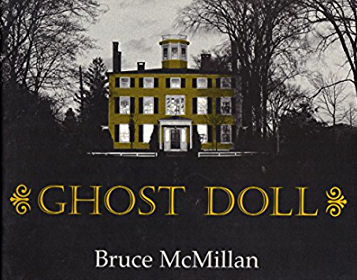 By BRUCE McMILLAN (Apple Island Books; 1983/97)
By BRUCE McMILLAN (Apple Island Books; 1983/97)
This 31 page tome, written and photographed by the prolific children’s book impresario Bruce McMillan, is typical eighties kiddie fodder in many respects. This is to say that it’s concerned primarily with dolls, has a hackneyed haunted house setting, and is visualized entirely in black and white photographs (not unlike another product of the early eighties kid book market, THE HAUNTED DOLLHOUSE by Terry and David Berger).
The book isn’t much, being burdened with an achingly perfunctory and simplistic narrative that concludes in a downright obnoxious happy ending. GHOST DOLL is, however, not without an authentically haunting resonance—just check out the reviews on Goodreads, which proclaim it “freaky-weird,” “extremely unsettling” and “So very, very creepy.”
Photographed at the historic Captain Lord Mansion in Kennebunkport, Maine, it involves a little girl named Chrissy. She’s embodied by (the now-grown up) Christen Wallingford, whose fearful and bewildered facial expressions appear genuine and unaffected. While wandering by the house one day Chrissie hears a voice imploring her to “Come in and play with me.” Upon entering the mansion (luckily the front door is unlocked) she finds a floating ghost doll whose owner abandoned it in the house years earlier.
This diaper-wearing dolly, as an afterward informs us, was a Betsy Wetsy doll whose real life owners told McMillan it “scared them.” It is indeed a scary looking creation, presented more often than not in glowing or transparent form amid starkly photographed black and white backgrounds, one of which (as a Goodreads reviewer pointed out) is set amid a windy staircase that closely resembles a birth canal. Far from enchanting or instructional (which appears to have been the intent), the effect is oppressive and nightmarish, although there are some impressive photographic effects on display (such as a closing box lid presented as a semi-indistinct blur).
Getting back to the story, it has the ghost doll lead Chrissy on a chase through the mansion and out the front door. The doll’s object is to find a new owner to assuage its loneliness, and it appears to have found that owner in the form of the unsuspecting Chrissy (lucky her!). The optimistic conclusion is unearned and plain wrong (the doll doesn’t appear any less scary in the final pages than it does in the preceding ones), but doesn’t lessen the book’s haunting spell, accidental though that spell probably was.
